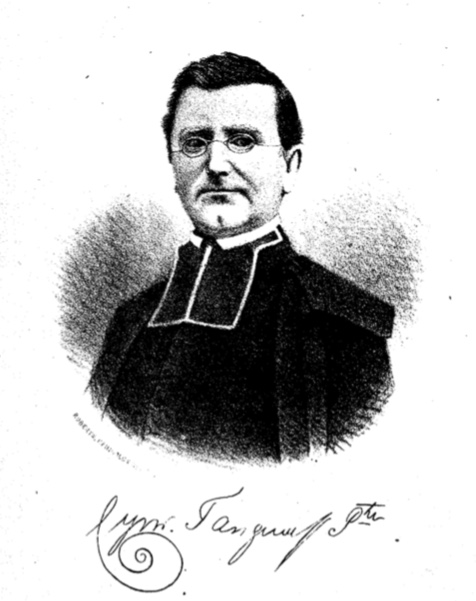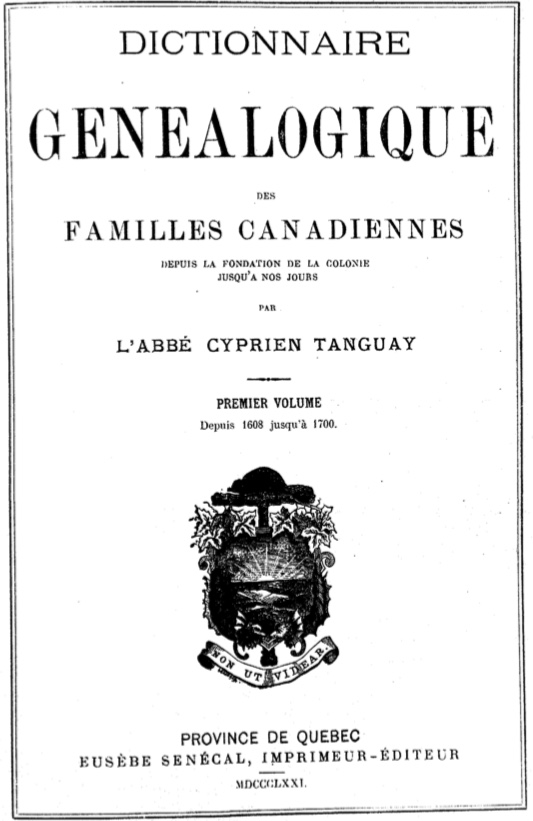Note: This reference is publicly available here and other places on the internet. The files provided here may be downloaded for your personal use without restrictions. Additional information on how to use Tanguay’s genealogical dictionary can be found by searching the internet on key words.
 Father Cyprien Tanguay, a French-Canadian Catholic priest and genealogist, is the author of the premier genealogical dictionary of early French-Canadian families. Collected and published over the period 1871-1890, Father Tanguay’s “Genealogical dictionary of the Canadian families since the foundation of the colony until our days” is an important source for early Quebec research and a good starting place for those researching your family’s French Canadian roots. In this case, a “genealogical dictionary” is different than the language dictionaries we’re used to. The seven-volume dictionary, with over 4,400 pages, contains the genealogical data on most of the French Canadian colonists from the late 1500’s to about 1800 and is also a wealth of information relevant to that period. While the collection has some minor errors, it is a prime reference for researchers.
Father Cyprien Tanguay, a French-Canadian Catholic priest and genealogist, is the author of the premier genealogical dictionary of early French-Canadian families. Collected and published over the period 1871-1890, Father Tanguay’s “Genealogical dictionary of the Canadian families since the foundation of the colony until our days” is an important source for early Quebec research and a good starting place for those researching your family’s French Canadian roots. In this case, a “genealogical dictionary” is different than the language dictionaries we’re used to. The seven-volume dictionary, with over 4,400 pages, contains the genealogical data on most of the French Canadian colonists from the late 1500’s to about 1800 and is also a wealth of information relevant to that period. While the collection has some minor errors, it is a prime reference for researchers.
For Vermet/Vermette researchers, Anthoine Vermet and Barbe Menard’s entry can be found in Volume 7, page 441 under the date 1669 (see elsewhere for my decision to use the name “Anthoine” instead of Antoine). I recommend you get yourself a good French/English dictionary and settle in for some fascinating reading!
Information contained in the volumes includes:
- Names of the husband and his wife (or wives)
- Names of the fathers of the husband and wife
- Names of the children
- Names of the children’s spouses
- Christening dates and places
- Marriage dates and places
- Burial dates and places
- Generations of the husband and wife from their immigrant ancestors
- Place of origin in France (not complete)
- Alternate ‘dit’ names for some early settlers
An index of the seven volumes is provided in both English and French in the linked personal folders. Entries within the volumes are in marriage-year order by the husband’s name. A year in large, bold numbers indicates the beginning of a new record. The entry itself is a record of the husband’s marriage and children by that marriage with references to the children’s marriages found elsewhere in the volumes. To help interpret the antiquated French in the volumes, here is a link to a Family Search page containing key French words, numbers, and phrases. I’ve found having a French/English dictionary at hand when doing research is a real benefit.
in the linked personal folders. Entries within the volumes are in marriage-year order by the husband’s name. A year in large, bold numbers indicates the beginning of a new record. The entry itself is a record of the husband’s marriage and children by that marriage with references to the children’s marriages found elsewhere in the volumes. To help interpret the antiquated French in the volumes, here is a link to a Family Search page containing key French words, numbers, and phrases. I’ve found having a French/English dictionary at hand when doing research is a real benefit.
Other information in the volumes:
In addition to name and families, Tanguay’s contains a wealth of valuable information about the early colony, including parish information, political figures, marriages to indigenous women, slaves held by the colonists, and much more. The list below will guide you in your research:
Volume One:
p. xix: Survey of the etymology and history of names. (Aperçu étymologique et historique sur les noms.)
p. xxxiii: Key to the genealogical dictionary. (Clef du dictionnaire généalogique.)
p. 593: Ecclesiastical provinces of France in the year 1631. (Provinces ecclésiastiques de France en l’année 1631.)
p. 595: Alphabetical list of the cities in France with the name of their province in 1631. (Table alphabétique des villes de France avec le nom de leur province en 1631.)
p. 601: Chronological list of parishes and missions of the province of Quebec having registers from 1621 to 1871. (Table chronologique des paroisses et missions de la province de Québec tenant registres, de 1621 à 1871.)
p. 607: Geographical list of the parishes of Quebec in 1871. (Table géographique des paroisses de la province de Québec en 1871.)
p. 611: Alphabetical list of the parishes of the province of Quebec in 1871. It gives the diocese and the number of each parish. (Table alphabétique des paroisses de la province de Québec en 1871.)
p. 617: Governors of New France from 1608 to 1700. It also lists the judges, provost-marshalls, doctors, and notaries. (Gouverneurs de la Nouvelle France de 1608 à 1700.)
p. 619: Lists of Lords of New France in 1681. It also includes a list of personnel of the different religious houses. (Tableau des seigneuries de la Nouvelle France en 1681.)
Volume Three:
p. 603: Slaves. A list of slaves in the 17th and 18th centuries giving the name of the slave, the names of the owner, the slave’s birth date, and the burial date and place of each slave. (Esclaves.)
Volume Four:
p. 607: Illegitimate births. A statistical picture of the total births, total legitimate births, and total illegitimate births for French Canada from 1701 to 1870. (lllégitimes.)
Volume Seven:
p. 495: Alphabetical list of proper names, their variations, and nicknames. (Table alphabétique des noms d’hommes, leurs variations et surnoms.)
p. 603: Alphabetical list of the names of women who do not have a family founder in Canada. (Table alphabétiqe des noms de femmes n’ayant pas souché en Canada.)
p. 685: List of women for whom only the first name is mentioned in the christening. (Liste des femmes dont le nom de baptême seul est mentionné.)
p. 687: Names of white men married to native (indigenous) women. (Noms des blanc mariés aux femmes indigenes.)
